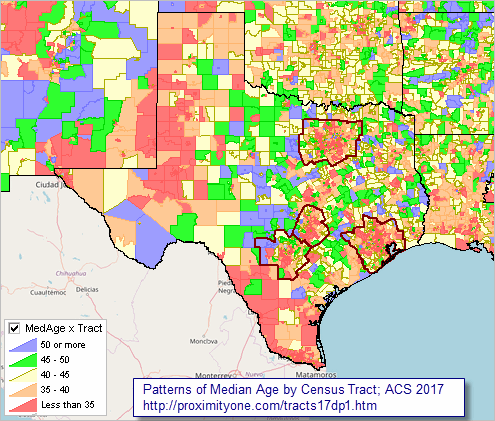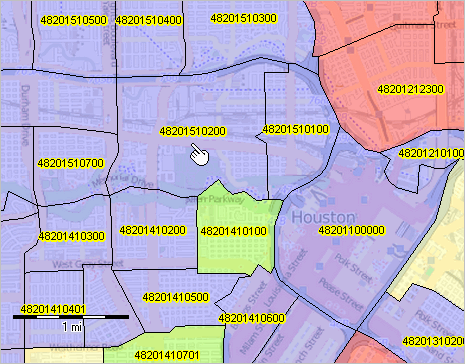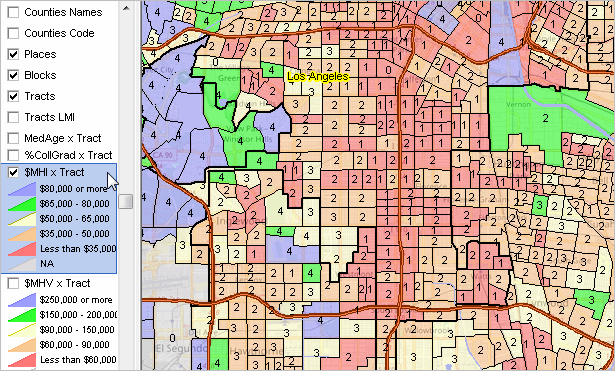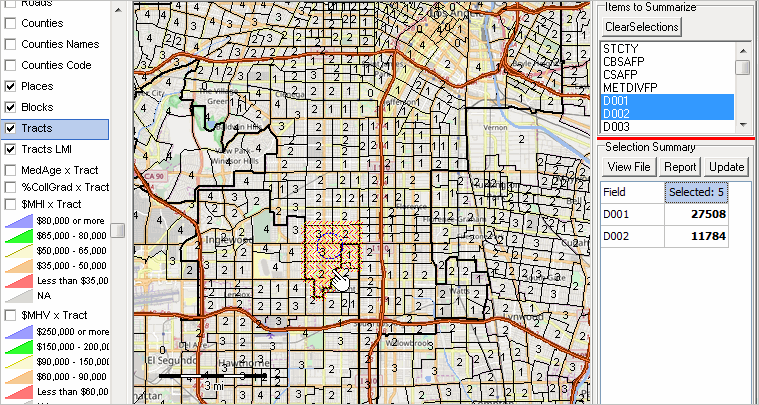

|
|
-- tools & data to analyze neighborhood level age, gender, race/origin, more -- determining & examining HMDA Low & Moderate Income census tracts January 2019. Census tracts are important for many reasons. It is easy to misidentify or misunderstand patterns and characteristics within cities, counties and metros which can become blurred using these higher level, more aggregate geographies alone. Many cities and counties that might be experiencing demographic-economic decline will often have bright spots that are groups of a few or many census tracts. See about using these data and tools for HMDA low and moderate income applications below This section is focused on tools, resources and methods that you can use to access, integrate and analyze U.S. by census tract general demographics data. The U.S. national scope Census Tracts Demographic-Economic Dataset contains approximately 600 subject matter items tabulated for each census tract organized into four subject matter groups: • General Demographics (this section) • Social Characteristics • Economic Characteristics • Housing Characteristics Use the interactive table in this section to view, query, rank, compare general demographics for all tracts in the U.S. Data in this section are based on the American Community Survey (ACS) 2017 5-year estimates. Current Estimates & Projections ACS tract/small area estimates lag by four years or more between the current year and reference year. ACS does not produce current year annual estimates but estimates based on a 5-year period. The 2017 ACS estimates are centric to 2015. Use the ProximityOne annual tract estimates and projections 2010 through 2023 for current year (e.g., characteristics as of 2018) estimates and anticipated change 5 years ahead. Patterns of Median Age Census Tract The following graphic shows percent population age 65 and over (item D017 in the interactive table below) by census tract based on ACS 2017 5 year estimates. Zoom-in view focused on Texas showing Austin-Round Rock, Dallas-Fort Worth, Houston, San Antonio metros with bold red-brown metros. (click link to view Situation & Outlook report), Click graphic for larger view, more detail (shows county layer) and legend color/data intervals. This map illustrates the geographic level of detail available using census tract demographics and the relative ease to gain insights using geospatial data analytics tools.  - View developed using CV XE GIS and related GIS project. Use the interactive ranking table in this section to view, query, rank, compare general demographics of the population, households and families in these areas. The scroll box shown below lists each of the subject matter items available for each area via the ranking table. The number at the left of the subject matter item is also used as the short name for the subject matter item in the column header in the ranking table. General Demographics Items
AGE AND GENDER
D001 Total population D002 Male D003 Female D004 Under 5 years D005 5 to 9 years D006 10 to 14 years D007 15 to 19 years D008 20 to 24 years D009 25 to 34 years D010 35 to 44 years D011 45 to 54 years D012 55 to 59 years D013 60 to 64 years D014 65 to 74 years D015 75 to 84 years D016 85 years and over D017 Median age (years) D018 18 years and over D019 21 years and over D020 62 years and over D021 65 years and over D022 18 years and over D023 Male D024 Female D025 65 years and over D026 Male D027 Female RACE D028 Total population D029 One race D030 Two or more races D031 One race D032 White D033 Black or African American D034 American Indian and Alaska Native D035 Cherokee tribal grouping D036 Chippewa tribal grouping D037 Navajo tribal grouping D038 Sioux tribal grouping D039 Asian D040 Asian Indian D041 Chinese D042 Filipino D043 Japanese D044 Korean D045 Vietnamese D046 Other Asian D047 Native Hawaiian and Other Pacific Islander D048 Native Hawaiian D049 Guamanian or Chamorro D050 Samoan D051 Other Pacific Islander D052 Some other race D053 Two or more races D054 White and Black or African American D055 White and American Indian and Alaska Native D056 White and Asian D057 Black or African American and American Indian and Alaska Native Race alone or in combination with one or more other races D058 Total population D059 White D060 Black or African American D061 American Indian and Alaska Native D062 Asian D063 Native Hawaiian and Other Pacific Islander D064 Some other race HISPANIC OR LATINO AND RACE D065 Total population D066 Hispanic or Latino (of any race) D067 Mexican D068 Puerto Rican D069 Cuban D070 Other Hispanic or Latino D071 Not Hispanic or Latino D072 White alone D073 Black or African American alone D074 American Indian and Alaska Native alone D075 Asian alone D076 Native Hawaiian and Other Pacific Islander alone D077 Some other race alone D078 Two or more races D079 Two races including Some other race D080 Two races excluding Some other race, and Three or more races D081 Total housing units CITIZENSHIP D082 Citizen, 18 and Over Population D083 Citizen, 18 and Over Population -- Male D084 Citizen, 18 and Over Population -- Female Example To determine the census tracts with the largest Asian Indians alone population: - Click ShowAll button. - Use horizontal scroll bar to make column D040 visible. - Click once on D040 column header then click once more on D040 column header (sort descending). - Scroll to top row value: tract NJ-023-001416 has the largest Asian Indian alone population among all tracts: 5,260. Census Tract Demographics Interactive Table ACS 2017 Click ShowAll button between queries. Click column header to sort; click again to sort other direction. See usage notes below table. Data based on ACS 2017 5 year estimates. See related interactive tables Note -- the table may require a few seconds or more than a minute to initially load depending on Internet speed. Usage Notes • Tract code column: Census 2010 census tract code (2017 vintage) structured as 11 characters: - ss (state postal code) + ccc (county FIPS code) + tttttt (Census 2010 census tract code). - all 11 characters required to uniquely identify a tract code. • Use Select Tract button to select one tract: - enter 11-character State+County FIPS code in edit box at right of Tract button. - click ShowAll button. - click Select Tract button to view/analyze selected tract. • Use StCty button to select/filter for all tracts in a county: - enter 1 character or null LMI: value (blank,1,2,3, or 4) - enter 5-character State+County FIPS code in edit box at right of StCty button. - click ShowAll button. - click StCty button to view/analyze tracts in this county for specified LMI. • Use CBSA button to select/filter for all tracts in a CBSA/metro: - enter 1 character or null LMI: value (blank,1,2,3, or 4) - get 5-character CBSA code from scroll section at right above table. - enter CBSA 5-character code in edit box at right of CBSA button for specified LMI. - click ShowAll button. - click CBSA button to view/analyze tracts in this CBSA. • Click ShowAll button between specific queries. • Cells with -1 value could not be estimated (for this geography and this time frame). Use address look-up tool to determine census tract, city/place and other geocode/area name/demographics based on address. View of Houston Area Showing Tract 48201510200 Create a similar view using the default US1.GIS project distributed with the CVXEGIS software. 
Examining Low & Moderate Income Tracts .. goto top The following graphic is a zoom-in view of Los Angeles city. Based on HMDA criteria tracts that are low income are labeled with "1" and tracts that are moderate income are labeled with "2". 
The Site Analysis tool is started to selected/extract data for specific tracts for further analysis. tracts. 
The View File button is clicked in the panel at left. A file with the selected tract records is created. Click this link to open the file: tracts17_06037_site1.dbf (open with excel) Importance of Census Tracts for Data Analytics Census tracts are important for many reasons. • Covering the U.S. wall-to-wall, census tracts are the preferred "small area" geography for superior data analytics. • The Census Bureau now produces annual tract demographic-economic data from the American Community Survey; .. there is an evolving time-series at the tract level creating new analytical opportunities. • Originally developed to equivalence neighborhoods, many still do. • Defined by the Census Bureau in collaboration with local groups, .. tracts typically reflect boundaries meaningful for local area analysis. • Defined generally for use with each new decennial census, most tract boundaries are stable .. and non-changing for ten years and many much longer. • Designed to average 4,000 population, .. there are more than twice as many census tracts (73,056) than ZIP code areas (33,129). • Tract boundaries are well-defined; unlike ZIP code areas which are subject to multi-sourced geographic definitions. • Many data developers (e.g., epidemiologists) use census tract geography to tabulate their own small area data .. enabling more effective use of those data with Census Bureau census tract data. • A statistical geographic area (in contrast to politically defined areas), .. census tracts are coterminous with counties; .. data at the census tract level can be aggregated to the county level. • Small area estimates for tracts are typically more reliable than for block groups. .. census tracts are comprised on one or more coterminous block groups. .. on average, a census tract is comprised of three block groups. • Census tracts are used by many Federal, state and local governments for compliance and program management. The ACS provides "richer" demographic-economic characteristics for national scope census tracts. While Census 2010 provides data similar to those items in the General Demographics section, only ACS sourced data provide details on topics such as income and poverty, labor force and employment, housing value and costs, educational participation and attainment, language spoken at home, among many related items. The approximate 600 items accessible via the tract dataset are supplemented by a wide range of additional subject matter. ACS census tract data are updated annually in December of each year. Find Geocodes Based on Address go top Summary of steps to use the "Find tract code based on address..." tool located in the upper right of this page. • Enter an address in the three line form (no ZIP code). • Click Find button and the census tract and related geocodes are returned. • Copy the last 11 digits of the returned GEOID to clipboard (e.g., 06085508101). • Paste that value in the edit box to the right of the "Select Area" button below the interactive table. • Replace the first two characters (e.g., 06) with the uppercase USPS state abbreviation (e.g. CA). • Click the Select Area button; the table refreshes with the selected tract. .. optionally right click the row and copy tract attributes to clipboard. .. paste in application such as spreadsheet program. .. join us in a Data Analytics Lab session to review use of operations. • Table empty? Click the ShowAll button then click Select Area button again. Use the Location-Based Demographics tool to view a demographic profile for an address. ProximityOne User Group Join the ProximityOne User Group to keep up-to-date with new developments relating to metros and component geography decision-making information resources. Receive updates and access to tools and resources available only to members. Use this form to join the User Group. Support Using these Resources Learn more about accessing and using demographic-economic data and related analytical tools. Join us in a Data Analytics Lab session. There is no fee for these one-hour Web sessions. Each informal session is focused on a specific topic. The open structure also provides for Q&A and discussion of application issues of interest to participants. Additional Information ProximityOne develops geodemographic-economic data and analytical tools and helps organizations knit together and use diverse data in a decision-making and analytical framework. We develop custom demographic/economic estimates and projections, develop geographic and geocoded address files, and assist with impact and geospatial analyses. Wide-ranging organizations use our tools (software, data, methodologies) to analyze their own data integrated with other data. Follow ProximityOne on Twitter at www.twitter.com/proximityone. Contact us (888-364-7656) with questions about data covered in this section or to discuss custom estimates, projections or analyses for your areas of interest. |
|
|